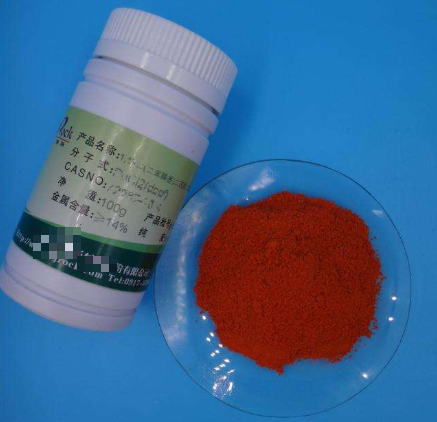Background and overview[1]
[1,1′-bis(diphenylphosphine)ferrocene]palladium dichloride dichloromethane complex (Pd(dppf)Cl2·CH2 Cl2) is a bimetallic solvent complex formed by Pd(II) and dppf, which is used to catalyze carbonylation, cross-coupling, and Suzuki reactions.
Various phosphine bridge transition binuclear complexes, mainly bidentate phosphine ligands, have attracted great interest from researchers due to their special structures and novel catalytic reaction properties. Ferrocene has its special molecular structure It has also received widespread attention. 1,1′-Bis(diphenylphosphine)ferrocene (dppf) is a new ligand that combines an organic bidentate phosphine ligand with ferrocene. It has a specific flexible skeleton and can be combined with another transition metal atom. Form a variety of bimetallic and multimetallic complexes.

Preparation[1]
Step 1. Dissolve 2.00 grams of sodium chloropalladate in 30 mL of absolute ethanol to obtain an ethanol solution of sodium chloropalladate;
Step 2: Dissolve 4.15 grams of 1,1′-bis(diphenylphosphine)ferrocene in 41 mL of methylene chloride to obtain the bis(diphenylphosphine)ferrocene of 1,1′-bis(diphenylphosphine)ferrocene. Methyl chloride solution;
Step 3. Add the ethanol solution of sodium chloropalladate described in step 1 dropwise to the dichloride of 1,1′-bis(diphenylphosphine)ferrocene described in step 2 under stirring conditions. In the methane solution, the reaction was stirred for 1 hour at a temperature of 25°C. After the reaction was completed, the reaction liquid was filtered to obtain 5.01 grams of orange-red [1,1′-bis(diphenylphosphine)ferrocene]palladium dichloride. The methyl chloride complex crystallized, and the yield was 90.46%.
This method directly uses dichloromethane as the solvent to synthesize the target product of the solvent complex [1,1′-bis(diphenylphosphine)ferrocene]palladium dichloride dichloromethane complex in one step , eliminating the synthesis process of the precursor PdCl2 (dppf), the reaction process is simple, the synthesis cycle is short, and it is easy to operate. The purity of the synthesized product reaches 99.4%, and the yield reaches 90.46%.
Apply[2]
5-Bromo-7-azaindole is an important intermediate for a class of anti-tumor drugs. CN201811598694.8 reports a preparation method of 5-bromo-7-azaindole, which includes the following steps: Using 2-amino-5-bromopyridine as raw material, iodine is introduced through 1) substitution reaction with iodine reagent to prepare 3-iodo-2-amino-5-bromopyridine; 2) 3-iodo-2-amino-5 A coupling reaction occurs between bromopyridine and methylbutynol to prepare 4-(2-amino-5-bromopyridin-3-yl)-2-methylbutan-3-yn-2-ol; described in 3) The ring-closing reaction of 4-(2-amino-5-bromopyridin-3-yl)-2-methylbut-3-yn-2-ol produces 5-bromo-7-azaindole; wherein, step 2 ) The catalyst used in the coupling reaction is bis(benzonitrile)palladium dichloride or [1,1′-bis(diphenylphosphine)ferrocene]palladium dichloride dichloromethane complex.
References
[1][China invention, China invention authorization] CN201210041027.6 Synthesis method of [1,1′-bis(diphenylphosphine)ferrocene]palladium dichloride dichloromethane complex
[2] [Chinese invention, Chinese invention authorization] CN201811598694.8 A preparation method of 5-bromo-7-azaindole

 微信扫一扫打赏
微信扫一扫打赏

